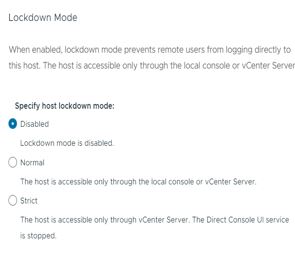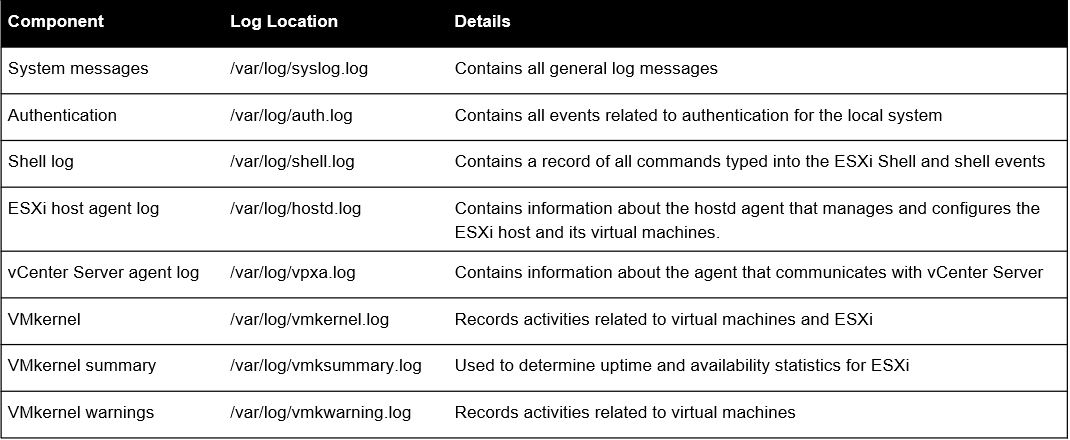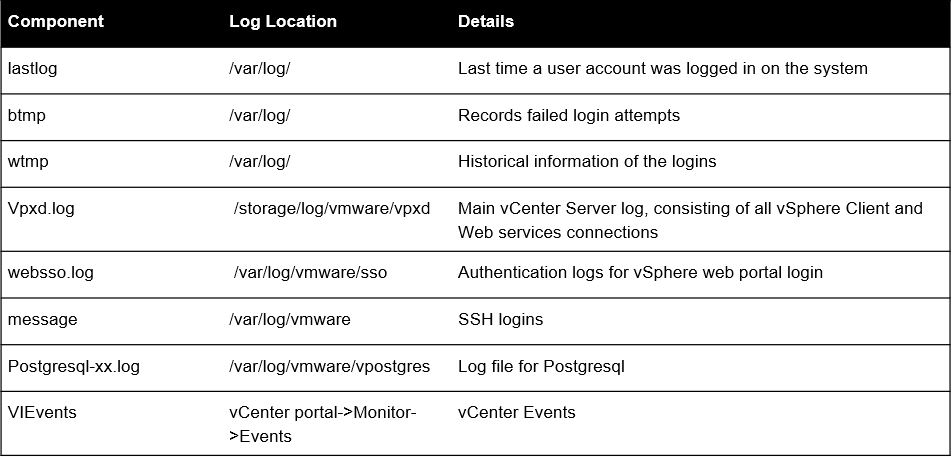This post provides detail on defense controls to secure VMware vSphere infrastructure from ransomware and other sophisticated attacks
Defending VMware vSphere from ransomware and other sophisticated attacks
Restrict Services/Ports and limit Administrative Access
- Ensure the firewall rules are configured to restrict access to ESXi host and vCenter from limited approved IP addresses
- Disable SSH and Shell Access to ESXi host and vCenter
- Isolate the management interface of vCenter, ESXi, vRealize, vMotion and vSAN interfaces to restricted VLANs
- Implement privileged access workstations for administrators to administratively access ESXi host and vCenter
- Disable Internet access for vSphere infrastructure
Restrict Malicious VIB execution in ESXi host
- Enable UEFI SecureBoot in ESXi host to restrict loading of unsigned VIB files during the booting process
- SecureBoot prevents changing of the VIB acceptance level settings in ESXI host
- Restrict forceful VIB installations option in ESXi host
- Query ESXi host to identify unsigned VIBs
esxcli software vib signature verify - Query all the ESXi hosts at scale to identify unsigned VIBs. Download the PowerCLI script from VMware and run against your vCenter using the SSO admin credentials
https://kb.vmware.com/sfc/servlet.shepherd/version/download/0685G00000vh19IQAQ
Restrict execution of non-VIB binaries in ESXi host
- Enable execInstalledOnly setting through kernel option in ESXi host to restrict non-VIB binaries such as ELF binary file, Shell scripts. Typically, ransomware files are in ELF format
esxcli system settings kernel set -s execinstalledonly -v TRUE - To view the status of execInstalledOnly settings
esxcli system settings kernel list -o execinstalledonly - Restriction activity of non-VIB binary execution is recorded in log files such as vobd.log,vmkernel.log and vmkwarning.log
- execInstalledOnly settings will not prevent execution of python based binary file. Python based ransomware or malicious files can circumvent this control
- From ESXi 8.x onwards, execInstalledOnly settings need to be enabled through kernel and runtime option
- execInstalledOnly settings in runtime option is enabled by default, but can be disabled without a ESXi reboot
Enable Trusted Platform Module (TPM) in ESXi host
- In vSphere 7.0U2 and newer, the archived on-disk ESXi configuration file is encrypted and protected from tamper. As a result, TA cannot read or alter this file, even if they have access to the ESXi host’s storage
- ESXi host use Trusted Platform Module(TPM) or Key Derivation Function (KDF) to encrypt configuration file
- TPM 2.0 chip manages the encryption key and seals the configurations
- TPM can use Platform Configuration Register (PCR) measurements to implement policies that restrict unauthorized access to sensitive data
- TPM can send ESXi host attestation report to vCenter
- To enable TPM mode in ESXi host
esxcli system settings encryption set --mode=TPM - Apply enforcement of execInstalledonly and secureboot settings in ESXi host. TPM will enforce these setting during the booting process
esxcli system settings encryption set --require-secure-boot=T
esxcli system settings encryption set --require-exec-installed-only=T
Enable Lockdown mode in ESXi host
- Enable Lockdown mode to enforce all the ESXI host operations only to be performed from vCenter
- Normal Lockdown Mode will enforce ESXi host to be accessible only through console (DCUI) and vCenter
- Strict Lockdown mode will enforce ESXi host to be accessible only through vCenter
- Exception users can be created to not lose their permissions when the host enters lockdown mode
- VMware recommends not to add administrator accounts under exception list
Password management and perform multifactor authentication
- Enforce Unique and strong passwords for all local accounts in ESXi host and vCenter
- Secure the Root Account password in Password Vault or PAM tools and automate the password rotation
- Review and limit privileged accounts to manage ESXi host and vCenter
- If in case ESXi joins active directory domain, then all management of ESXi should happen from vCenter
- Change the name of the ESXAdmin group in Active Directory to avoid ESXi Administrator membership exposures
- Enforce and perform multi-factor authentication (MFA) for access to vCenter portal and vSphere API calls
- Consider using a dedicated identity solution for vSphere infrastructure
Centralized Monitoring and Robust Backup Solutions
- Collect and monitor below mentioned logs from ESXi host in SIEM solutions
- Collect and monitor below mentioned logs from vCenter server in SIEM solutions
- Implement robust and secure backup solutions
- Implement Immutable backups(write once and read many) in an air gapped network to avoid backup file encryptions or deletions
- Perform multi-factor authentication to access backup files
Restrict VIX API Guest Operations
- Consider disabling VIX API Guest operations in the guest VM configuration to restrict ESXi host to perform guest operations in VMs
- This may impact VMware Consolidated Backup (VCB) and VMware Update Manager (VUM), both of which call the VIX API for guest operations
/etc/vmware/config
guest.commands.enabled = FALSE - Create custom roles to limit the privileges to perform guest operation such as executions
Perform YARA scan against ESXi host
- Perform Yara Scans against all ESXi hosts to look for malicious artefacts
- Mount ESXi host in any of the DFIR Linux machine using utilities such as sshfs
- Create Yara rules and specify the identified malicious artefacts such as strings, filenames, paths, file hash and scan the mounted ESXi directory and identify the impacted ESXi host
sshfs -o allow_other,default_permissions root@<ESXi Host IP Address>:/ /mnt/esxi
yara <rules> -r /mnt/esxi


